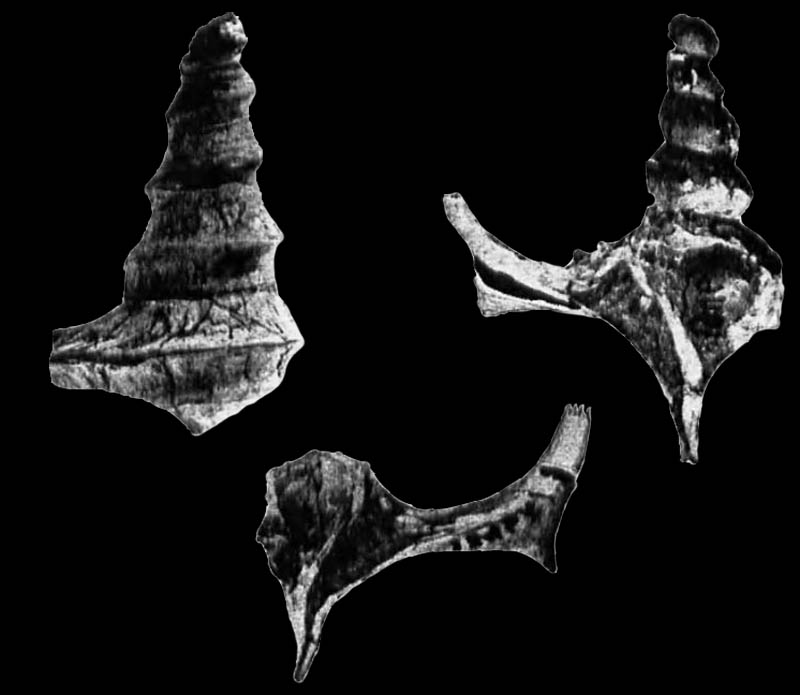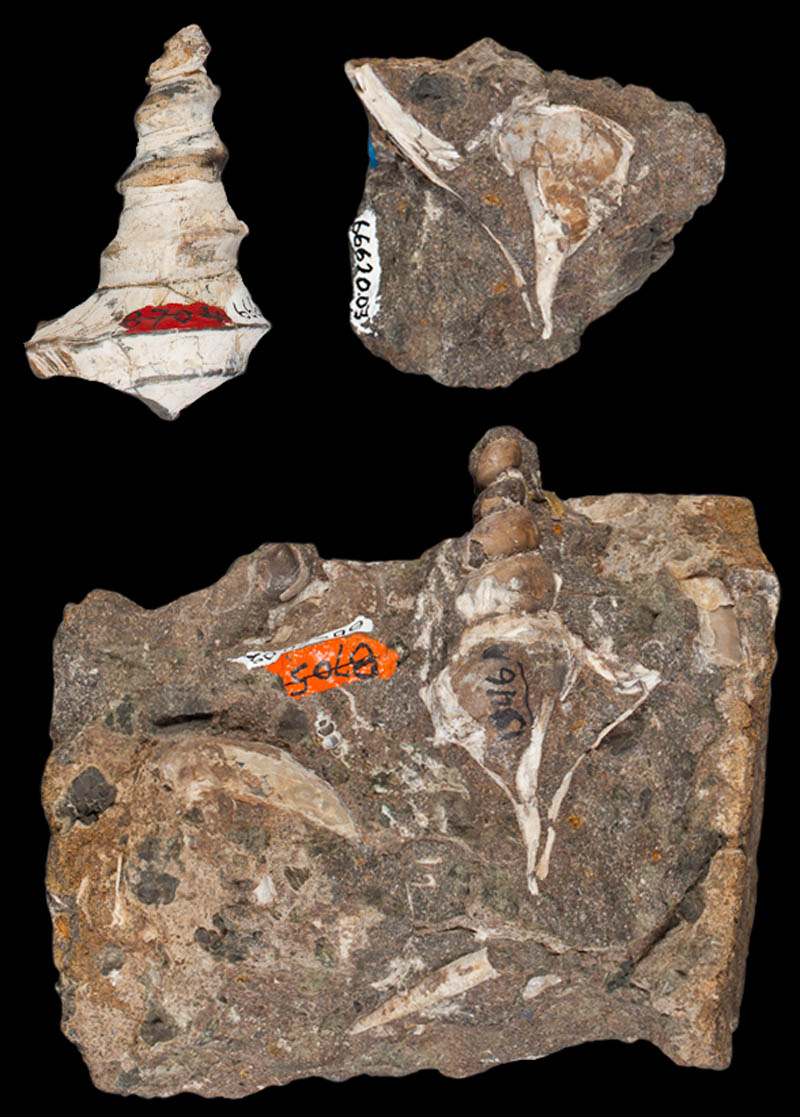|
edit SideBar
|
Species / Pseudanchura Biangulata
Stromboidea
Original description of Aporrhais biangulata by Anderson F.M., 1938 :
- "The holotype (Calif. Acad. Sci. type Coll.) is incomplete as to spire and canal, and measures as follows: height, 57mm.; with of body whorl, 22mm.; aperture distinctly triangular in outline. The wing, as shown in the paratype, (Calif. Acad. Sci.,type Coll.), rises obliquely from the upper part of the aperture in a broad curve, and at its outer end forms a distinct expansion. This expansion rises into an acuminate point not quite parallel to the axis of the spire and terminates below in a distinct spur. The canal is long and nearly straight; height of paratype (incomplete), 57 mm.; with of body whorl mm.; outer margin of wing, from end of spur to terminus of upper point, directed slightly backward. This species has been found not only in the Perrin zone of the Hulen beds, on Hulen Creek (probably Brewer’s locality), but also in the basal beds of the overlying Chico series on Cottonwood Creek. The holotype and also the paratype came from the latter horizon, at Locality 1346-A (Calif. Acad. Sci.). Most of the examples found here were firmly cemented in the matrix of a conglomerate and could not be extracted without breaking. Anchura biangulata, nov. appears to have survived the epoch of disturbance between the Shasta and Chico series, whereas Anchura angulata (Gabb) has not been found in the Shasta series and may be confined to the later group."
Locus typicus: “Huling Creek”, North fork of Cottonwood Creek, Shasta County, California, USA; Locality no. 1546A (C. A. S.)
Stratum typicum: "at the base of the upper Cretaceous"
Anchura biangulata Anderson, 1938, pl. 9, fig. 4,5,6
Pseudanchura biangulata (Anderson F.M., 1938); Top left: holotype no. CAS 66620.01; Top right: paratypes nos. CAS 66620.03, CAS 66620.02; Coll. & Copyright California Academy of Sciences
History and Synonymy
1864
Anchura angulata Gabb, 1864 (in part)
In his description of « Aporrhais » angulata (1864, p.128), Gabb stated that:
- "Mr. Brewer collected three specimens at Huling Creek, near the Cottonwood Creek locality, resembling this species in surface ornamentation, and in the shape of the upper whorls, but in which the last whorl was distinctly bicarinate" (Anderson, 1958)
1958
Anderson, 1958:
- "This locality has been unsuccessfully searched for Gabb’s species, although a number of distincty bicarinate examples of a larger species have been found which in other respects agree with the form indicated by Gabb. The angular ridges on the body whorl completely encircle it, the more prominent upper ridge passing outward into the wing, or outer lip expansion; the lower one becomes lost. The whorls of the spire are not rounded,as in Anchura angulata, but the most part are angular in section parallel to the axis; these whorls bear 8 to 10 vertical ribs, or varices, which are crossed by numerous revolving threads.
- "Gabb (1864, p. 128) had evidently noted this species, stating that: “Mr. Brewer collected three specimens at Huling Creek, near the Cottonwood Creek locality, resembling the species (above described) in surface ornamentation and in the shape of the upper whorls, but in which the last whorl was distinctly bicarinate. He did not show the aperture, the form of the outer lip expansion (wing), the outward form of the whorls, nor their surface ornamentation, supposing all of them to conform to his holotype from near Martinez, which they closely resemble."
2014
Kaïm A., Jenkins R.G., Tanabe K., Kiel S., 2014, p.421:
- "Description. The best preserved specimen (CAS 73132) is composed of six high-spired whorls. Two earliest are rounded with poorly visible ornamentation spiral riblets while the third whorl bears no ornamentation apart from strong median keel. The aperture and apertural extensions not preserved in the investigated specimens."
- "Material and occurrence. Two poorly preserved juvenile specimens (CAS 73132, 73133). Eagle Creek (Late Barremian, Early Cretaceous).
- "Remarks. P. biangulata has been reported from a couple of localities in the Ono area by Anderson (1938) and it remains uncertain whether they were seep locations or "normal" deep water sediments. Most likely the association of P. biangulata with seep carbonates is fortuitous as aporrhaids are gastropods typical for soft bottom marine environments during Mesozoic times and they have been found at various Jurassic to Paleocene seep deposits (Kaim et al. 2008b; Kiel et al. 2010, 2013; Agirrezabala et al. 2013)."
- Measurements: The holotype is incomplete as to spire and canal, and measures as follows: height, 57mm.; with of body whorl, 22mm.
- Locus typicus: Eagle Creek, Shasta County, California
References
- Anderson, Geol. Soc. Am, Special Papers no. 16, 1938, p. 134, PI. 9, figs. 4, 5, 6
- Kaïm A., Jenkins R.G., Tanabe K., Kiel S., 2014''' : Mollusks from Late Mesozoic seep deposits, chiefly in California, 2014, Zootaxa 3861 (5), p.421
|


